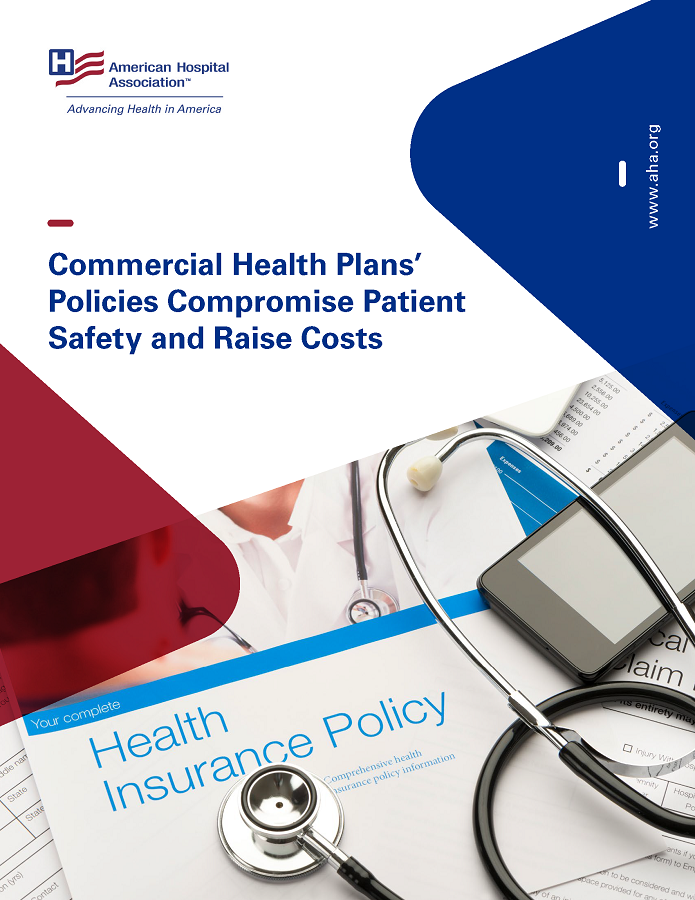This is a republication of the article “Commercial Health Plans’ Policies Compromise Patient Safety and Raise Costs”, with the title above.
AHA — American Hospital Association
July 2022
Private commercial health insurance coverage has long served as the central pillar of our national health insurance system.
Not only are commercial health insurance plans the dominant source of health coverage for most Americans and employers but Medicare and Medicaid programs often rely on private health insurance plans to administer their health benefits.
The cost of commercial insurance is increasing at an unsustainable rate — squeezing individuals and families, employers, and public programs.
The average family insurance premium has increased 47% over the past 11 years — faster than general inflation and more than any other part of the health care system.
This contrasts with hospital prices, which have grown an average of 2.1% per year over the last decade, about half the average annual increase in health insurance premiums.
And, more recently, hospital prices have grown much more slowly than the overall rate of inflation.
The average family insurance premium has increased 47% over the past 11 years — faster than general inflation and more than any other part of the health care system.
KEY TAKEAWAYS:
- Prior authorization
- Initial ineffective treatments (step therapy or fail-first policies)
- Medical necessity policies (flawed or overly stringent)
- Purchase of auxiliary products (from commercial insurers)
- White bagging (banning the provider from using their own medication inventory)
- Charge from electronic payment methods from insurers (paying for getting paid)
1.Prior authorization
Many health plans apply prior authorization requirements in ways that
- create dangerous delays in care,
- contribute to clinician burnout and
- significantly drive up administrative costs for the health care system.
2.Initial ineffective treatments (step therapy or fail-first policies)
- Insurers often force patients to suffer through periods of ineffective treatment before permitting access to the most appropriate therapy.
- Use of step therapy or fail-first policies is increasing, and its inappropriate application often results in short-term savings for insurers …
- .. while increasing provider administrative burden and adding downstream costs due to patient delays and complications.
3.Medical necessity policies (flawed or overly stringent)
- Insurers frequently establish flawed or overly stringent medical necessity policies that prevent patients from obtaining the necessary care recommended by their physician.
4.Purchase of auxiliary products (from commercial insurers)
- Many commercial insurers leverage their market power and position to steer providers to purchase their auxiliary products …
- … that drive up administrative costs and line insurers’ pockets.
5.White bagging (banning the provider from using their own medication inventory)
- White bagging is an insurer practice that effectively bans a provider from using their own medication inventory to supply drugs used to treat patients in their facility …
- … and prohibits providers from having oversight of the procurement, storage and handling processes, …
- which has important implications for safety and efficacy.
6.Charge from electronic payment methods from insurers (paying for getting paid)
- Many insurers use electronic payment methods that require providers to pay money to receive their contractual reimbursements from commercial insurers.
- The insurers often receive incentives from credit card companies or payment vendors for issuing these payments.
- Providers should not have to pay to get paid.

Need for Action
- Some commercial health insurers have implemented policies that add billions of dollars in added unnecessary administrative costs to the health care system while compromising patient care.
- Commercial health plan abuses must be addressed to protect patients’ health and ensure that medical professionals, not the insurance industry, are making the key decisions in patient care.

Several under-examined features of commercial health insurance contribute to unsustainable cost growth — many of which are unnecessary at best and harmful to patient health and workforce wellbeing at worst.
Insurers’ use of policies that deny or delay medically necessary care — often applauded by insurers as ways to control cost — have become extraordinarily burdensome on hospitals, providers and patients.
Massive administrative costs are due in large part to the complex payment and reporting requirements of various commercial health insurers.iii
More frequently they include excessive and unjustified application of
utilization management tools and prior authorization requirements.
These practices add costs by slowing down the provision of care, requiring providers to purchase additional information technology tools, and requiring them to hire additional staff to manage the requirements.
Ironically, many commercial health insurers point to these processes and requirements as part of their efforts to manage health care spending.
What is often ignored are the complicated business and financial
relationships between many health insurers and intermediary service providers.
For example, the three largest pharmacy benefit managers (PBMs) are owned by commercial health insurers.
The administrative services-heavy data and analytics company Optum drives more revenue for UnitedHealth Group than its commercial health insurance arm, UnitedHealthcare (UHC), despite UHC being the largest commercial health insurer in the country.
These complex relationships create potential conflicts of interest. Specifically, the insurer may put in place an administrative requirement on providers that drives the provider’s need to procure the intermediary’s tool or service.
As the nation works to improve the affordability of the U.S. health care system, holding health plans accountable will help to reduce unnecessary spending on administrative processes and services while simultaneously improving patient access to care and reducing undue burden on our health care workforce.
1.First, we recommend identifying and measuring unnecessary administrative costs because of health plan abuses and excessive requirements.
Currently, much of this information is reflected in national datasets as spending on hospitals, health systems and physicians because they are the ones who must absorb the cost of paying staff and acquiring the expensive products needed to comply with these commercial health insurer policies.
2.Second, we must adopt policies to streamline, standardize and reform these burdensome processes to reduce administrative inefficiencies.
This report provides information on the areas with the most
opportunity for improvement.
Need for Reform
- Some commercial health insurers have implemented policies that add billions of dollars in unnecessary administrative costs to the health care system while compromising patient care.
- The need for reform is now.
- Commercial health plan abuses must be addressed to protect patients’ health and ensure that medical professionals, not the insurance industry, are making the key decisions in patient care.
- The health care system should take action to eliminate, streamline or standardize a number of these commercial health insurer administrative practices. Doing so would reduce unnecessary and low-value services, improve patient care and outcomes, and reduce health system costs.
The AHA will continue to do its part by working to hold commercial health insurers accountable while advancing a responsible regulatory and legislative agenda in these areas.

Originally published at https://www.aha.org.








